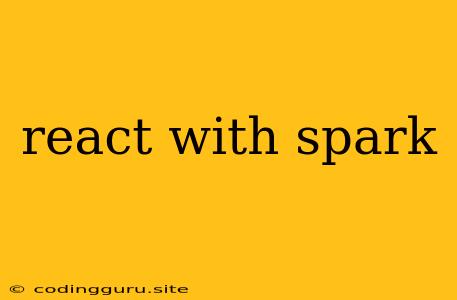Combining the Power of React and Apache Spark: A Comprehensive Guide
The modern world of data-driven applications demands both interactive user interfaces and efficient data processing. While React excels in building dynamic and engaging front-ends, Apache Spark is a powerhouse for large-scale data analysis and processing. This guide delves into the powerful combination of React with Spark, exploring how these technologies can work together to build robust and data-rich applications.
Why Combine React and Apache Spark?
The marriage of React and Spark offers a unique set of advantages:
- Interactive Data Visualization: React empowers you to build highly responsive and engaging user interfaces. You can leverage its component-based architecture to create dynamic visualizations of data processed by Spark, offering users real-time insights.
- Scalable Data Handling: Spark excels in handling massive datasets, performing distributed computations, and facilitating efficient data transformations. Integrating it with React allows you to build applications that can process and present large amounts of data effectively.
- Real-time Data Updates: Spark can be used for streaming data processing, allowing your applications to react to real-time events and update visualizations accordingly. This dynamic capability, powered by React, keeps users informed with the latest data insights.
Bridging the Gap: Connecting React to Spark
The key to integrating React with Spark lies in establishing a communication channel between the two technologies. Several approaches can be employed:
- REST APIs: Spark can be configured to expose REST endpoints that serve data to a React application. This approach provides a clean separation between the data processing logic and the front-end, enabling independent development and scaling.
- WebSockets: For real-time updates, websockets can be used to establish a persistent connection between React and Spark. This allows data changes in Spark to be reflected instantly on the React front-end.
- Message Queues: Utilizing message queues like Kafka, you can facilitate asynchronous communication between React and Spark. This approach is ideal for scenarios where the data processing involves complex computations or requires buffering.
Example: Building a Real-time Data Dashboard
Let's imagine we are building a real-time data dashboard for a company monitoring their website traffic. This dashboard should display various metrics like page views, user engagement, and conversion rates.
Backend (Spark):
- Spark Streaming: Utilize Spark Streaming to process real-time website traffic data from a source like Kafka.
- Data Aggregation: Aggregate the incoming data to calculate relevant metrics like page views per minute, average session duration, etc.
- REST API: Expose a REST endpoint using Spark's web framework to serve aggregated data to the React frontend.
Frontend (React):
- Component-Based Architecture: Design components to represent different data visualizations, like charts, tables, and gauges.
- Fetching Data: Make API calls using the Fetch API or a library like Axios to retrieve data from the Spark backend.
- Dynamic Updates: Use the
useEffecthook to fetch data regularly and update the visualization components based on the latest data.
This example demonstrates the workflow of combining React and Spark to build a responsive and data-driven application.
Challenges and Considerations
While React and Spark are powerful tools, their integration comes with some challenges:
- Data Transfer Optimization: Managing the transfer of large datasets between Spark and React can be a performance bottleneck. Consider optimizing data serialization, compression, and data filtering.
- Real-time Updates and Latency: Handling real-time data updates requires careful consideration of network latency and potential delays. Implement strategies like data caching, batching, or optimistic updates to minimize impact on user experience.
- Security: Ensure secure communication between React and Spark by implementing authentication, authorization, and data encryption measures.
Conclusion
Combining React and Spark enables you to build powerful and data-driven applications that deliver interactive user experiences. By understanding the core concepts and best practices discussed in this guide, you can leverage the strengths of both technologies to create compelling applications that effectively process, analyze, and visualize data in real-time.
